WESTERN DERBY TRAIL - OLD WEST END (PART)
TRAIL 2 – AROUND DERBY’S OLD WEST END (part)
This trail explores an important part of Derby’s Old West End, which is still very much talked about and loved by many of the city’s older inhabitants for the close friendships and community spirit it engendered. The houses were mainly of poor quality and often lacked basic amenities. Eventually, many of them were pulled down and the residents re-housed on the eastern side of Derby.
The West End had its own church, St John the Evangelist. The Bishop of Lichfield had recognised that the town needed an additional church to serve its ever-growing number of worshipers, which was much the same in other parts of the country. It was the passing of the Church Building Act in 1818 that enabled the West End to afford its own church.
It was an important area for heavy industry with Markeaton Brook providing a vital source of power. The arrival of the Great Northern Railway, which passed through the heart of the West End, led to the demolition of all the houses that stood in its path. Today, the area houses a large number of students from the University of Derby, with some buildings used for educational purposes.
Friends Meeting House
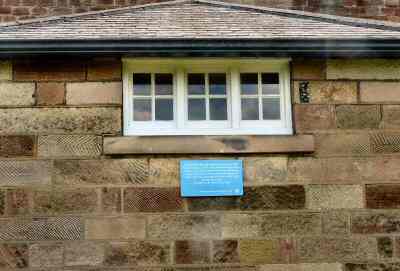
The Quakers, as they were later called, began by holding small meetings in private rooms, until numbers had grown sufficiently for them to acquire their own premises. Derby was referred to in Robert Simpson’s book, the ‘History and Antiquities of Derby’ published in 1826 as one of the first places where the faith was established.
In the early 1800s, The Friends Meeting House in St Helen’s Street was built for the Quakers. It is believed to contain masonry of considerable antiquity from the old Hospital of St Helen.
George Fox, the founder of the Quakers, was imprisoned for blasphemy in the notorious Derby Town Gaol, between 1650 and 1651. At his trial, he bade the court “To tremble at the word of the Lord.” To which the justice, Gervase Bennet, responded by calling Fox and his supporters “Quakers”, a name that remains. The Meeting House still survives almost unchanged to this day.
Radio Derby

In 1971, two months before it was due to officially start broadcasting Radio Derby went on air to cover the Rolls-Royce crash from a temporary studio at Sutton Coldfield. The bankruptcy of the local aero-engine manufacturer caused consternation in Derby not only among employees and their families but also among Derbyshire Building Society investors who thought their money was at risk. Queues formed outside the Society’s head office in Iron Gate intent on withdrawing their savings, thinking the Building Society had invested in Rolls-Royce and was in financial difficulties. This was not the case as Building Society law did not allow investment in private companies.
The station’s output is speech-based, featuring news, sport, weather, travel, interviews, and discussions, mixed in with music and competitions. In 2011, the station became the first BBC local radio station to win the prestigious ‘Station of the Year’ award for the 300,000 to 1 million listener category. The highly regarded station has also won several other awards.
Rykneld Tape Mills

The Rykneld Mill complex is made up of an impressive group of silk mills which for generations had found work for weavers of ‘narrow fabrics’ as they were once called. It is probably the most complete surviving range of 19th-century industrial buildings in Derby. Construction began in 1808, as a silk mill for Thomas Bridgett. Further expansion took place in 1817 and 1825 as well as late 19th-century additions.
By the turn of the 20th century, the company was one of the biggest employers in Derby and following Bridgett’s death in 1833, his relations continued to maintain the business until 1870. William Able then took it over, until the Lilley family acquired control. They introduced the name Rykneld Tean in 1929, which linked it with the factory in Tean, Staffordshire which remains in business. The Derby mills are listed as Grade II* buildings and have recently been turned into apartments.
Brook Street Baptist Chapel
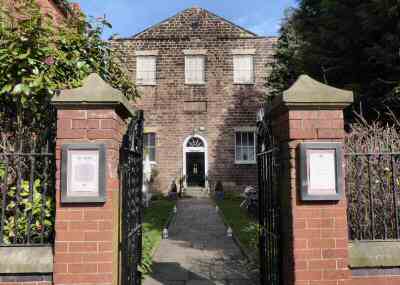
The former Baptist Chapel stood by the side of Bridgett’s, South Mill. It was built in 1802 as Derby’s first Baptist Chapel and enlarged in 1815. By 1842, it was proving too small for the increasing congregation numbers and the chapel moved into the converted townhouse of William Evans in St Mary’s Gate. Four years later the Wesleyan Reformers started to rent the building, before its eventual purchase. They continued to use the chapel and school rooms at the back until 5 May 2002, when the final service was held and the building closed as a place of worship. It is listed as a Grade II building and was a restaurant for several years.
Banks Mill
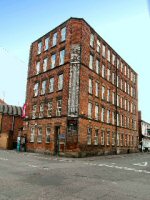
Built-in the 1860s for John and William Rickard, it was one of the last silk mills erected in Derby. In recent times the mill has been turned into studios by Derby University, who own and manage the site. The studios were set up to retain graduate-level skills in the creative industries in the Derby area. By creating easy-in/easy-out workspace studios, and business and professional development support, graduates were helped to earn a living from those skills, either as sole traders or businesses. In recent years the mill has held periodic ‘Open Days’ when visitors can browse or buy a vast range of unique artwork, jewellery, glassware, photography, ceramics, textiles, sculptures, poetry and much more.
Markeaton Brook/Brook Walk
From Bridge Street, you can take a pleasant stroll along Brook Walk by Markeaton Brook to a weir and a tunnel that takes the brook underground before it remerges and joins the River Derwent. The brook rises from a source south of Hulland Ward and flows for the most part through the countryside, before entering the culvert on Brook Walk.

Markeaton Brook played an important role in the early industrial development of Derby providing power for several mills along its course. The stretch of the brook along what is now called Brook Walk was where boats used to transport goods to and from factories along the bankside. The stone steps to a former landing stage can still be seen near the end of Searl Street at the back of what are now University student lodgings. The cast-iron bridge that crossed the brook and gave access to Searl Street has been replaced with a modern one of similar style mainly for the use of the student population.
Before culverting, Markeaton Brook passed through Derby above ground, a foul-smelling channel of water filled with all types of obnoxious contents. The smell though was not the only problem as the brook wreaked periodic havoc on the inhabitants of the town who lived in, or whose businesses were in its path when it flooded. After many years of comparative inactivity, the problem was eventually solved and the brook was culverted.
Church of St John the Evangelist
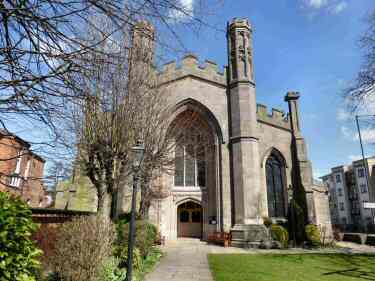
St John’s Church was for many years the centre for community life in Derby’s old West End. Consecrated in 1828, the first ‘new’ church in Derby to be sanctified since the Reformation and is now the only surviving Commissioners’ Church in Derby.
Before St John’s Church was built, the population of Derby, like many other towns and cities had been growing rapidly, with the advent of the industrial revolution. As a result, there were not enough churches to meet the demand of worshipers. Also, another problem had arisen with the increase of dissenters such as the Baptists, Methodists and Quakers. The church wanted to retain as many worshipers as possible and not lose them. Something had to be done. This led to a campaign being started to get the government to take immediate action to commence a major church-building programme.
A Church Building Act was passed by Parliament in 1818, under which a Commission was set up to provide grants totalling £1.5 million, a very significant sum of money for those days, for the building of 600 churches. These churches were known as Commissioners’ Churches.
It was under this scheme that Derby’s, St John the Evangelist Church was built. Despite the considerable restrictions the Act placed on the release of the money the building went ahead. The commissioners’ paid £2,547 while an additional £4,300 was raised by public subscription. The land on which it was built was given by the Hurt family whose townhouse was in Friar Gate and it was designed by Francis Goodwin, who, at the time, was working on the County Gaol in Vernon Street. It was intended to accommodate 1,200 – 1,300 worshipers, with 650 free seats and in design is rather similar to King’s College Chapel, Cambridge.
Golden Eagle public house
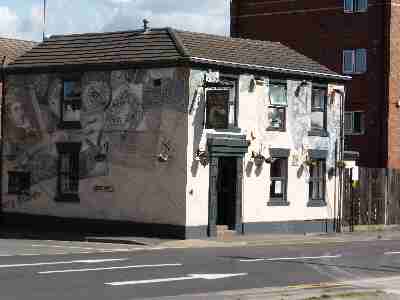
After numerous name changes the Golden Eagle on the corner of Agard and Searl Street, has been returned to its original name by the present owners. Markeaton Brook is to the rear, crossed by a modern bridge, provided by the University of Derby to replace a much older one. The pub was first recorded in 1835 but may go back further. For a short period in the 1990s, it was returned to its old name, but that did not last long before it was changed again. It is now the brewery tap for Derby’s Titan brewery, which is brewed by the current owner and his son.
The pub has recently been converted to embrace the history of the West End of Derby, with a new hand-painted sign and murals on the outside walls depicting highlights from local history. Inside there is more historical detail to peruse, including a range of local history books to browse whilst taking refreshments. Additionally, there are lots of old bottles, glasses and a whole host of beer mats to inspect and one or two other surprises. In a pub that is rapidly becoming a favourite with by-gone lovers. It changed hands recently.
Nuns Green
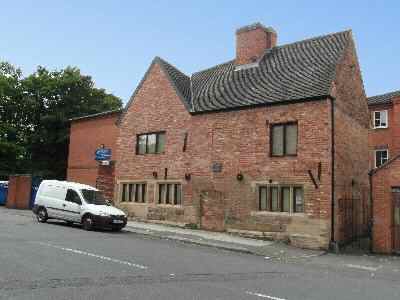
King’s Mead Priory was a Benedictine Priory, situated in what is now Nuns Street, and dedicated to ‘St Mary de Pratis.’ It was founded in about 1160 and became a popular place in Derbyshire for the nobility to send their daughters to be educated. It was built on land owned by Darley Abbey under whose rule it came. However, by 1250, it had become separately endowed.
After the Dissolution of the Monasteries, the convent came under the control of the mayor and burgesses of Derby. When much of the land was converted into closes and tofts, leaving the remainder as common land. This became something of a dumping ground. It covered an area stretching from Bridge Street to Ford Street and remained as an eyesore until in 1768 an Act of Parliament was passed. This granted permission for the land adjoining Ashbourne Road to be developed.
The road continued to be called Nuns Green; until the 19th century when the name was changed to Friar Gate. It was mostly developed due to the efforts of architect Joseph Pickford, who was involved in the purchase of at least four building plots, one of which he used to build his own house. As a result of Pickford’s activities, Friar Gate became one of Derby’s finest streets. A further Act in 1792 released the remainder of the land for sale.
A plaque on the wall of 126 Nuns Street, erected by Derby University states “This house probably dates from before the dissolution of the Convent of King’s Mead to which it belonged, in 1536. It is likely that it was timber-framed and that the lower parts of the walls were later rebuilt in brick with stone dressings.”
Britannia Mill
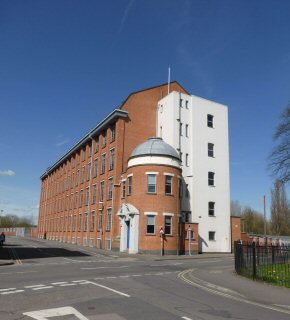
There may have been a mill on the site where Britannia Mill stands today, dating back to the Domesday Book. Markeaton Mill as it was then called was probably built around 1818, on the site of an old corn mill. It was rebuilt by a hosiery company, Moore, Eadie, Murcott Goode, Ltd as a textile mill. The mill leat remained, and there was a water-driven turbine in use until the mid-1930s.
On the other side of the road from the mill is the West End flat green bowls club. It has been in existence since 1913 and is now the last surviving flat green bowls club in the city. Across the brook from the mill is a children’s play area, which was given by Emily Mundy of Markeaton Hall early last century.
The mil got its present name from the statue of Britannia, which stood on the top of the cupola over the entrance for many years. It specialised in the making of high-quality knitwear, something new to the town at that time.
The manufacturing company managed to survive until the 1960s, when it decided to move to Leicester, taking the statue of Britannia with it. Fortunately, the University of Derby took the premises over in the 1990s and converted them into a School of Art and Design.
Brick and Tile public house
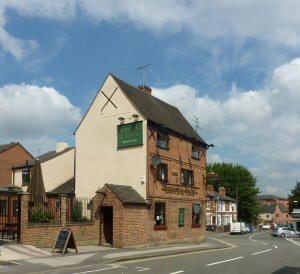
The Brick and Tile pub was one of several pubs that sprang up to serve the cattle market when it was held at the west end of Nuns Green. It got its name from the brickyards on Nuns Green, owned by Richard Roe and his family in the 1720s. Fifty years later the brickyards were owned by Joseph Pickford, the celebrated architect.
